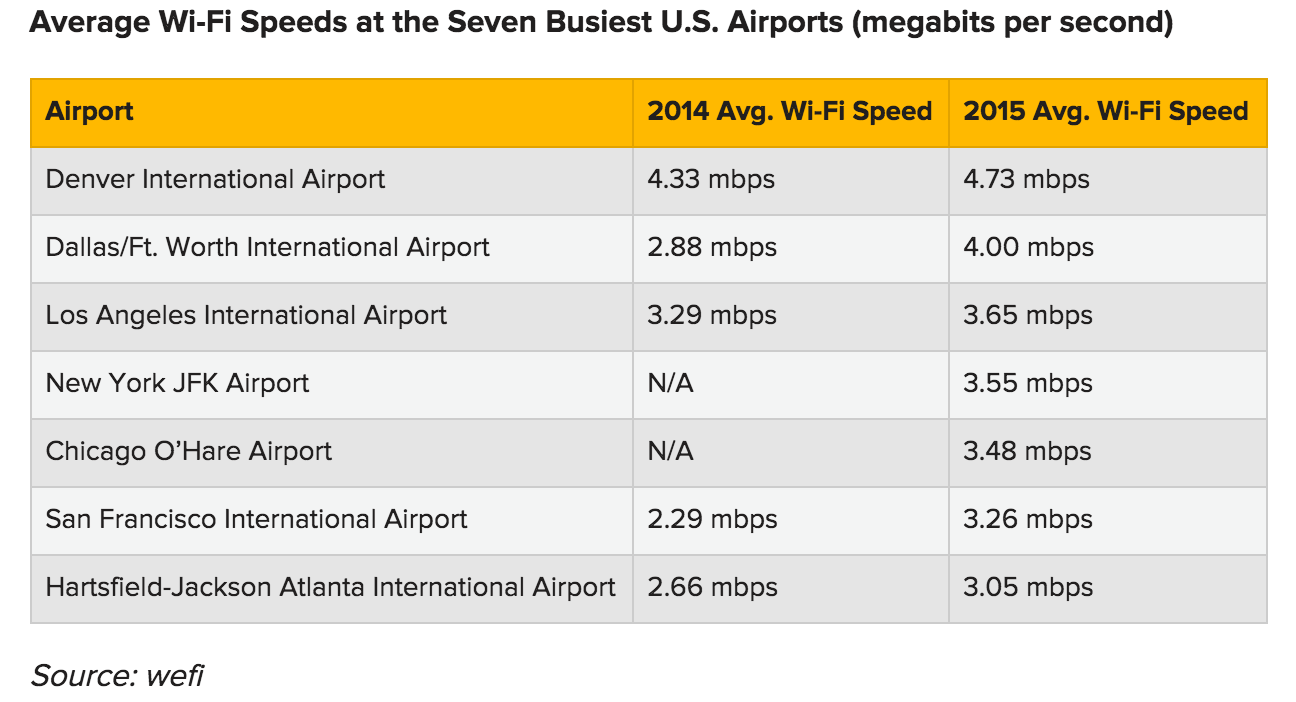Skift Take
If airports want to welcome and comfort travelers, that phrase's definition implies more than charging outlets and iPads at gates or restaurants featuring local cuisines. Having a slow Wi-Fi connection isn't an extension of home for many travelers but it's encouraging to see faster speeds will soon become more common.
Some travelers visiting family or journeying away for the holidays may find faster Wi-Fi than they have at home at several U.S. airports.
Boingo announced this week that, for the first time, it introduced Wi-Fi speeds of up to 50 mbps at seven U.S. airports: New York’s JFK and LaGuardia, Newark Liberty, Baltimore/Washington, Chicago’s O’Hare and Midway, and Boston’s Logan International Airports. Considering the average U.S. Internet speed is about 12 mbps, that’s a huge leap for airport Wi-Fi (see chart below for average Wi-Fi speeds at the busiest U.S. airports).
Of the millions of passengers flying through these airports alone through the new year, only those who are Boingo subscribers can access the faster Wi-Fi. That’s about 258,000 travelers, according to the company’s 10-Q third quarter SEC filing. Boingo said the faster speeds are “also available to consumers who receive access to the Boingo network via the company’s wholesale partnerships. These consumers include select American Express cardholders enrolled in the American Express Preferred Plan.”
After logging in with their Boingo credentials, all subscribers will receive the fastest speeds available. Depending on network capacity at the time of use, speeds may vary from a minimum of 20 mbps to up to 50 mbps. Boingo’s free connection gets travelers a 5 mbps connection depending on the airport and network capacity.
The faster speeds are part of Boingo’s SMART network installation during the past year at these airports. SMART stands for secure, multi-platform, analytics-driven, responsive and tiered and these networks enable cell phone carriers to offload traffic from their networks onto Boingo’s carrier-grade Wi-Fi networks. They also provide travelers with instant connectivity without the need for software or passwords.
“Analytics-driven and responsive go hand-in-hand,” said a spokesperson for Boingo. “Boingo’s SMART Networks are location-aware and use historic and predictive analytics to provide actionable business intelligence to airport IT teams, such as utilization and traffic flow figures.”
“SMART Networks are designed to balance flexibility, capacity and connection performance with an adaptable network infrastructure. SMART Networks are responsive, and we continually evaluate the service being provided, ensuring that it’s delivering the defined user experience for each class of service.”
Boingo provides Wi-Fi to nearly 60 airports, representing more than 50% of North America’s top 50 busiest airports and more than 30% of the world’s top 30 busiest airports.
The Daily Newsletter
Our daily coverage of the global travel industry. Written by editors and analysts from across Skift’s brands.
Have a confidential tip for Skift? Get in touch
Photo credit: iPhone accessing Boingo Passpoint Secure network. Boingo

